The Marketing Power of Generative AI and Augmented Reality
PMG, eye square, and Snap have partnered together to understand consumer perspectives of GenAI experiences, the impact for brands, and best practices.

GenAI and Augmented Reality (AR) are rapidly transforming consumers’ everyday lives by changing how they interact with each other and reshaping how digital marketing captures attention.
The prevalence of AI in daily life is evident, with a significant majority of users reporting having used AI previously and expressing satisfaction with the results. Marketers are also embracing GenAI, with three-in-four indicating a desire to increase its use 1.
In collaboration with eye square and PMG, Snap Inc. conducted a comprehensive study utilizing in-context environments to assess impact of GenAI creatives on consumer engagement and marketing outcomes with over 14,800 respondents aged 13-44 years across 7 markets - Australia, Canada, France, Germany, Saudi Arabia, UK and US. We also spoke to 150 marketing professionals in the US to get their perspective on the use of GenAI.

GenAI AR and Video Formats Drive Stronger Full-Funnel Performance
The study revealed that combining GenAI video and AR Lens formats creates a powerful formula for brand storytelling. These ad types consistently outperformed static ads across key metrics such as attention, recognition, and engagement, leading to measurable uplifts in both upper- and lower-funnel brand metrics.
GenAI-powered AR Lenses and video ads are particularly effective at attracting and retaining attention:
A substantial majority of users interacted with AR Lenses for an extended period.
Compared to static ads, GenAI video ads and particularly GenAI AR Lenses showed significantly higher rates of users watching for at least two seconds.
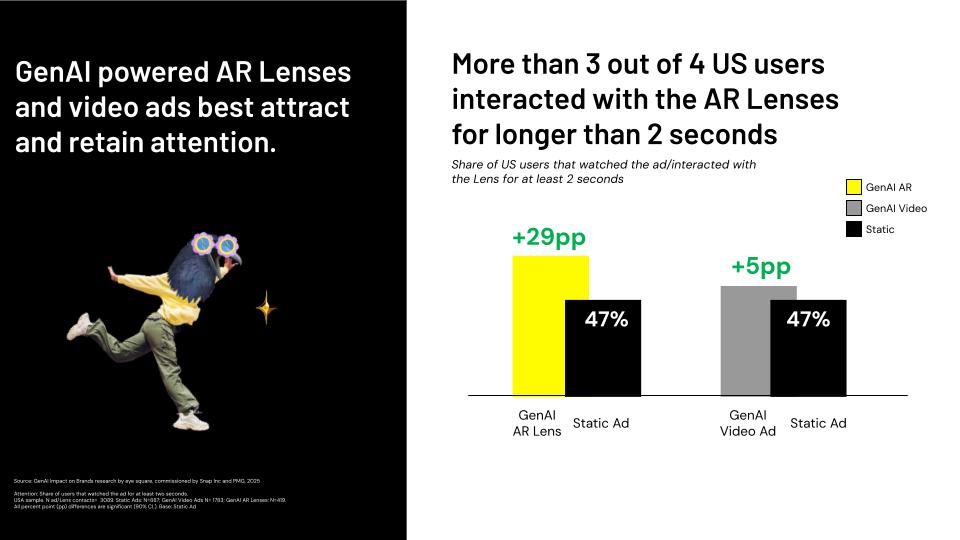
Beyond attention, GenAI-powered video ads and AR Lenses enhance engagement. They are perceived as more unique and entertaining compared to static ads 1. Furthermore, these engaging ads translate to positive brand perceptions.
Study participants seeing GenAI assets led to significant improvements in brand image statements, including being seen as more premium and innovative 1. They also showed a comprehensive brand impact from awareness and intent, all showing outperformance relative to static.
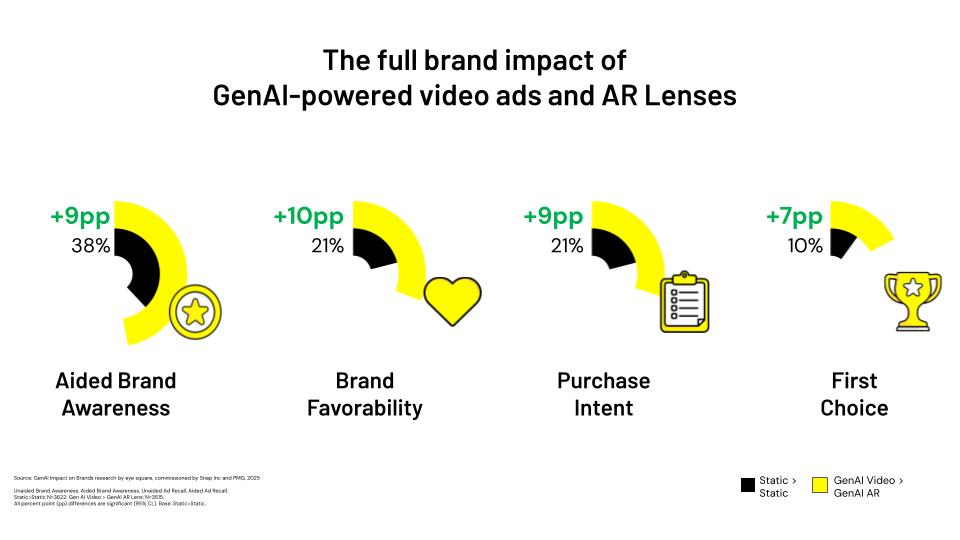
These formats also spurred curiosity and advocacy, with substantial increases in users wanting more product information, visiting the brand website, talking about the brand, and recommending the brand to others.
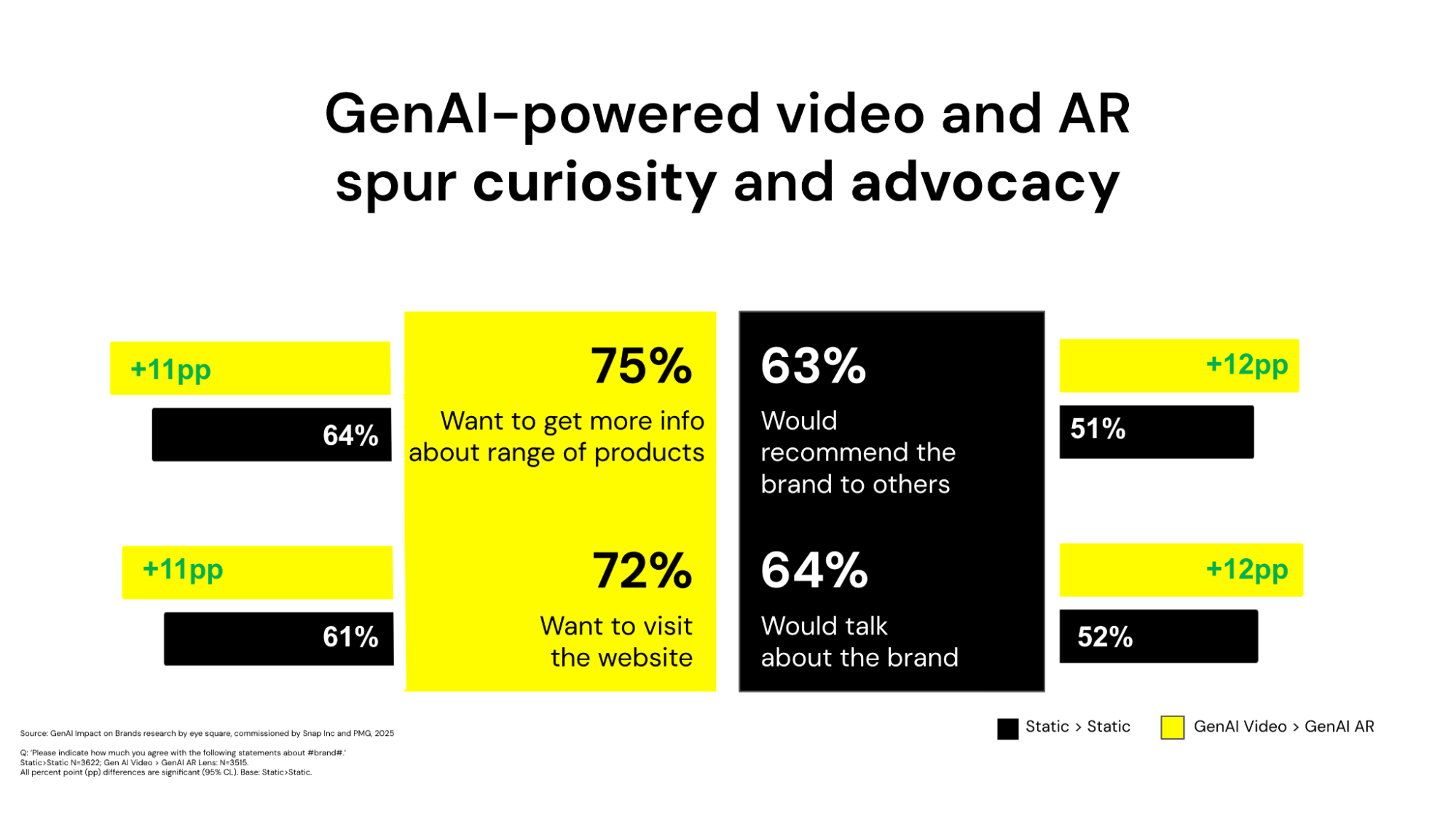
Transparency Impacts Trust and Perception
A crucial finding was the importance of transparency in GenAI advertising. Both consumers and marketers emphasize the need for disclosure. Consumers are significantly more likely to accept the use of AI in ads when it is transparently disclosed compared to when it is not. A large majority of social media users also believe GenAI content should be marked as such.
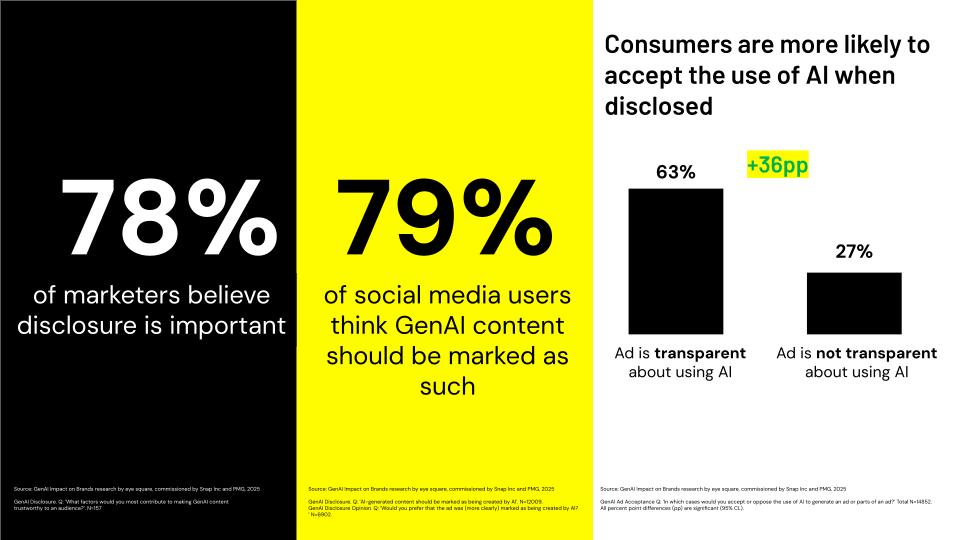
Interestingly, the impact of disclosure varies by generation. For example, in the US, Millennials tended to view AI-powered video ads more positively after being informed of AI's involvement, while Gen Z reacted more negatively.
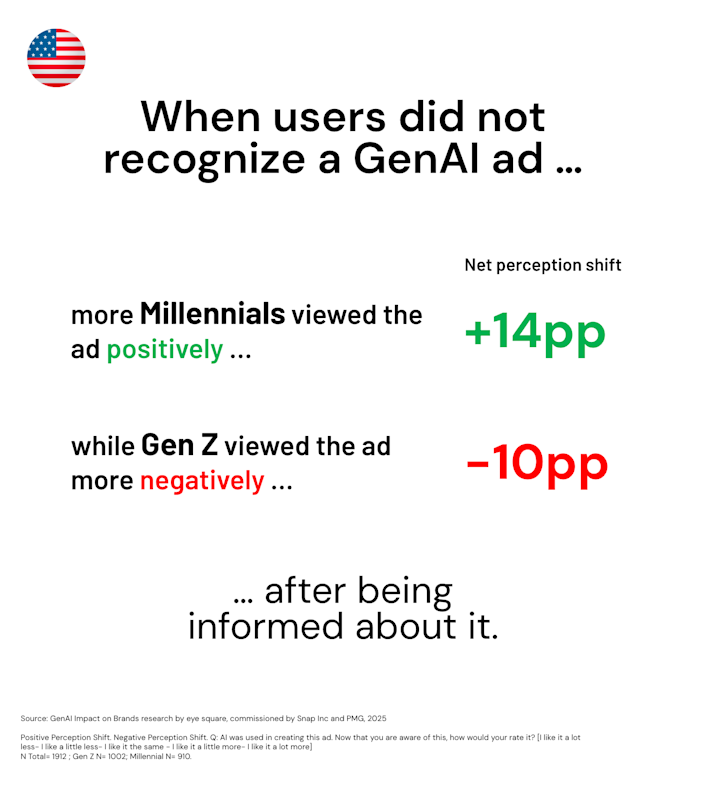
However, GenAI AR Lenses helped to mitigate any negative impact and even increased consumers' confidence in recognizing future GenAI ads, particularly among Millennials. Snapchatters were more likely to report that the GenAI AR Lenses made them feel more positive, which we hypothesize is translating into the aforementioned negative-impact cushion 1.
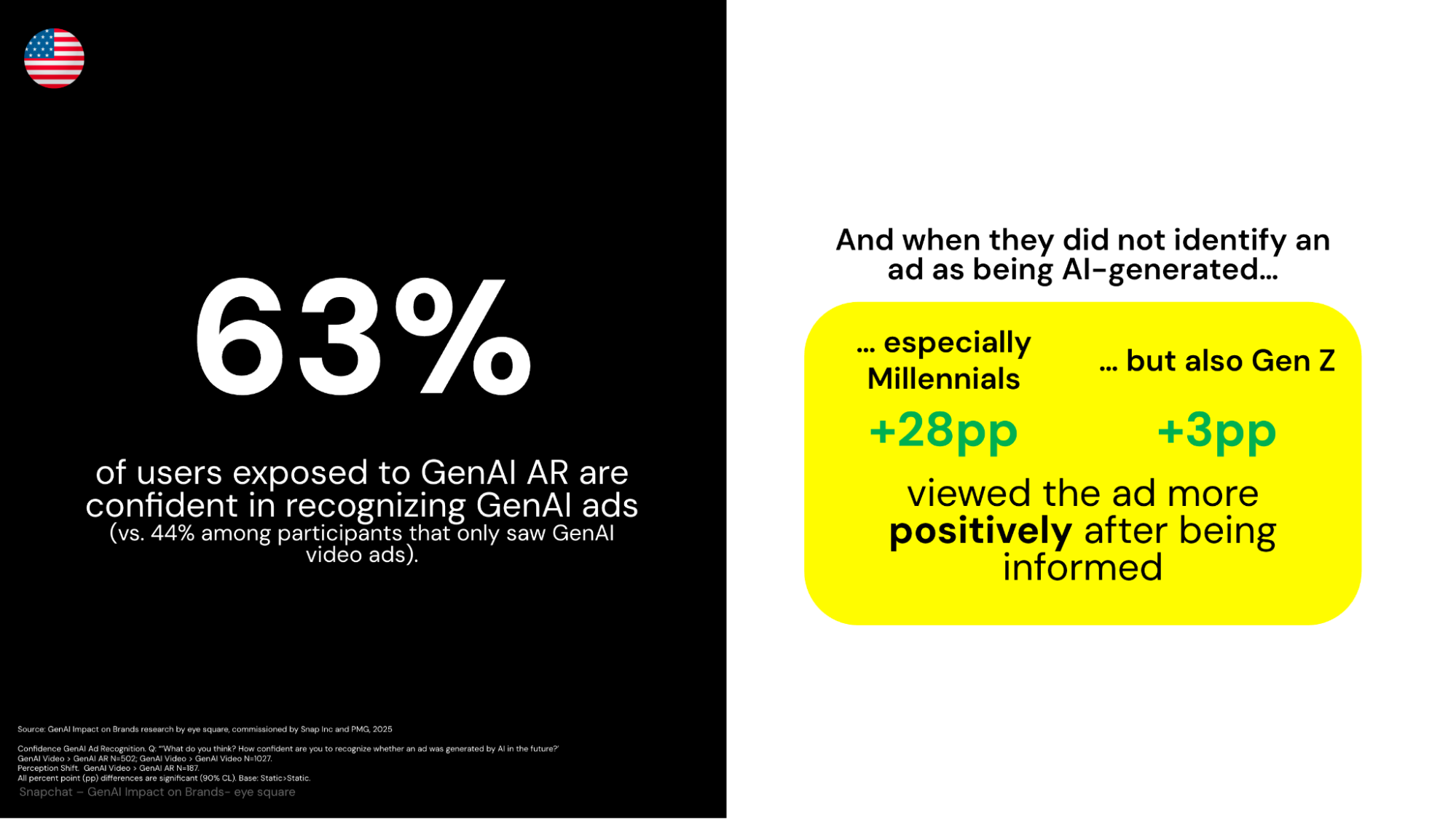
GenAI is a Tool, Not a Replacement For Humans
Despite the widespread adoption and effectiveness of GenAI, marketers largely view it as a tool to enhance, rather than replace, human creativity. While 87% of marketers found GenAI tools to be effective at enhancing their marketing performance and 68% agree that GenAI will replace traditional methods of content creation, there is still a desire for human involvement and control over its use 1.
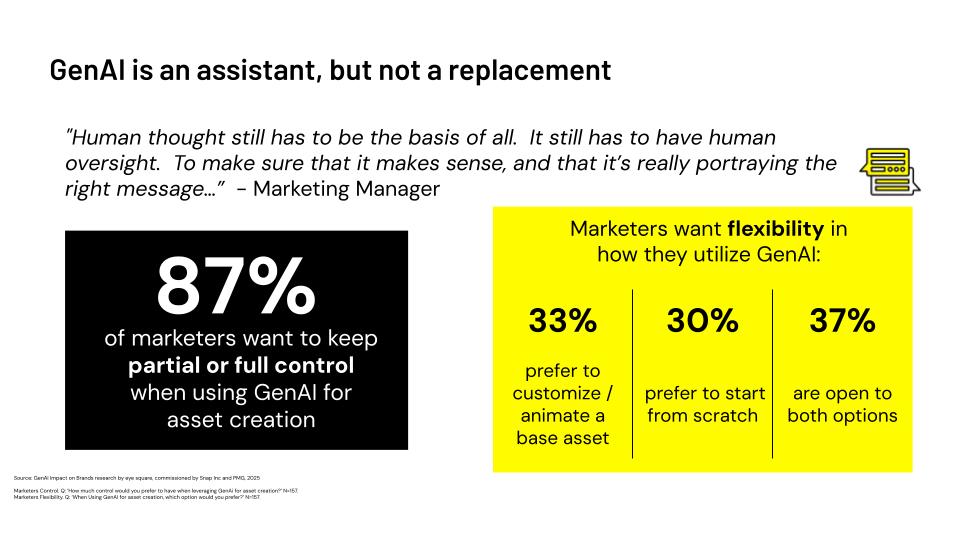
This desire for control may stem from existing concerns regarding the potential for misinformation and lack of accountability, over-reliance on AI that leads to reducing human interaction, and data misuse or leakage 1. Specifically in advertising, marketers are concerned with false advertising and indistinguishability of real ads from fake ones, in addition to ethical concerns involving the creative process and the limited ability of GenAI to match human creativity and nuance 1.
"At PMG, we believe technology should serve humanity. As we embrace the potential of Generative AI, transparency is not just a principle, it is a responsibility. Our commitment to transparency is reflected in Alli, our proprietary marketing operating system, and stems from our belief that trust is earned when people understand how and why technology is used. We are focused on using AI to enhance human connection, not replace it, and that begins with making its role visible, understandable, and accountable."
Best Practices for AI Usage in Marketing
Consumers reported being comfortable with brands using AI to generate a variety of parts in an ad, including images, video content, music, and dialogues/speech.

But the acceptability of various elements varied, with higher acceptance for products, objects, environments, and backgrounds, followed by animals. Meanwhile, humans are less accepted. Similarly, animation-style ads are more accepted than photorealistic ads. Therefore, marketers should use caution if and when GenAI might be used to depict humanistic elements in their ads.
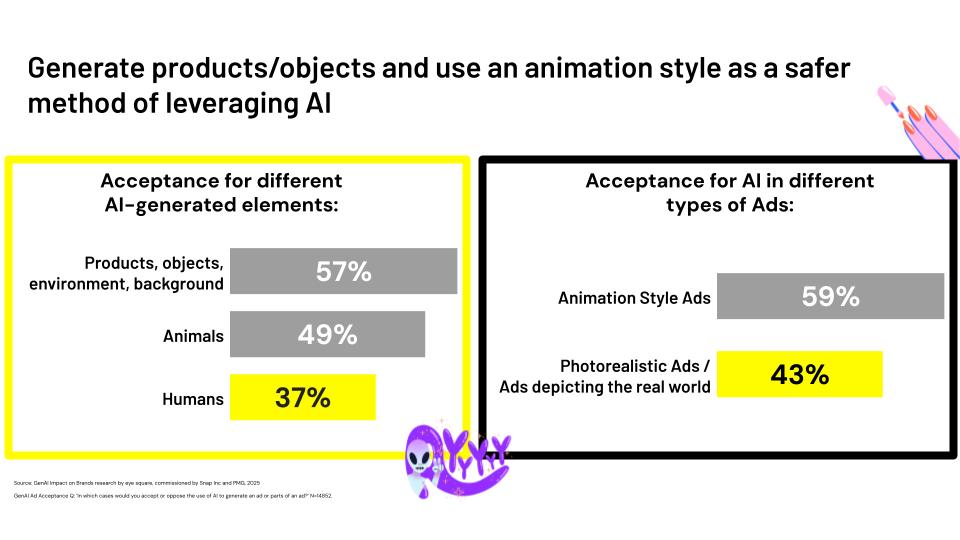
Beyond GenAI powering creative development, personalized AI experiences are highly valued by consumers, with top interests including AI-generated product recommendations, AI-powered chatbots, and virtual try-on experiences 1. Marketers should recognize this demand and start experimenting with GenAI — not just in creative development, but any way in which it can enhance their customers’ experiences.
Takeaways for Brands
Capture Attention & Strengthen Perception with Immersive GenAI Formats: AR Lenses and GenAI-powered video ads are effective at capturing attention, driving positive brand perceptions, and fostering emotional connections.
Use Positive Disclosure to Build Trust and Distinction: Transparency around AI usage is crucial and can build trust. Brands should position themselves as innovative leaders by highlighting the collaboration between AI and human creativity.
Recognize GenAI as an Enhancer of Human Work, Not a Replacement: Integrate GenAI to augment human creativity and productivity, particularly for tasks benefiting from brainstorming or rapid iteration. Maintaining a human touch in the final creative output is key to preserving authenticity and building trust.
Embrace GenAI for Visual Storytelling: Leverage GenAI to enhance specific ad elements like visuals, music, or dialogue, especially in animation-style visuals where consumer acceptance is highest.
Learn more here about how brands can tap into new AR experiences powered by GenAI on Snapchat!
Details on Methodology
Our research employed a holistic, mixed-methods approach, including a quantitative survey of over 14,800 consumers aged 13-44 across Australia, Canada, France, Germany, Saudi Arabia, the United Kingdom, and the United States, qualitative expert interviews with 15 US marketing managers, and a quantitative survey of over 150 US marketing professionals.
The consumer survey involved a test design where participants were randomly assigned to one of four test groups, exposing them to different ad formats: human-generated static ads, GenAI-assisted video ads, and a combination of GenAI video ads followed by an AR Lens.
Snapchat can help your business grow.
